Atten Babler Meat FX Indices – May ’16
The Atten Babler Commodities Meat Foreign Exchange (FX) Indices remained at or near record highs during Apr ’16. USD/Meat Importer FX Index finished at a new record high value throughout the month while the USD/Domestic Meat Importer FX Index increased to the second highest figure on record. The USD/Meat Exporter FX Index declined for the second consecutive month but remained at the fourth highest figure on record.
Global Meat Net Trade:
Major net meat exporters are led by Brazil, followed by the U.S., the EU-28, India and Australia (represented in green in the chart below). Major net meat importers are led by Japan, followed by Russia, Mexico, Hong Kong and Saudi Arabia (represented in red in the chart below).
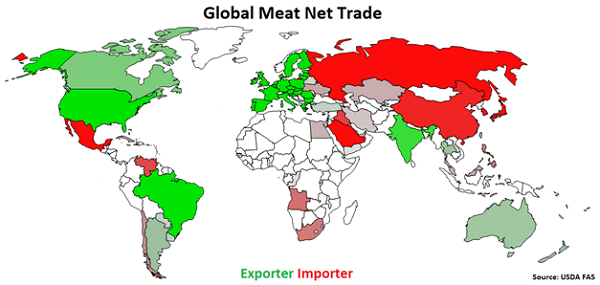 USD/Meat Exporter FX Index:
The USD/Meat Exporter FX Index finished lower for the second consecutive month during Apr ’16, declining 4.3 points to a value of 170.0. The USD/Meat Exporter FX Index remained at the fourth highest figure on record and has increased 48.1 points since the beginning of 2014 and 7.0 points throughout the past six months. A strong USD/Meat Exporter FX Index reduces the competitiveness of U.S. meat relative to other exporting regions (represented in green in the Global Meat Net Trade chart), ultimately resulting in less foreign demand, all other factors being equal. USD appreciation against the Argentine peso and Brazilian real has accounted for the majority of the gains since the beginning of 2014.
USD/Meat Exporter FX Index:
The USD/Meat Exporter FX Index finished lower for the second consecutive month during Apr ’16, declining 4.3 points to a value of 170.0. The USD/Meat Exporter FX Index remained at the fourth highest figure on record and has increased 48.1 points since the beginning of 2014 and 7.0 points throughout the past six months. A strong USD/Meat Exporter FX Index reduces the competitiveness of U.S. meat relative to other exporting regions (represented in green in the Global Meat Net Trade chart), ultimately resulting in less foreign demand, all other factors being equal. USD appreciation against the Argentine peso and Brazilian real has accounted for the majority of the gains since the beginning of 2014.
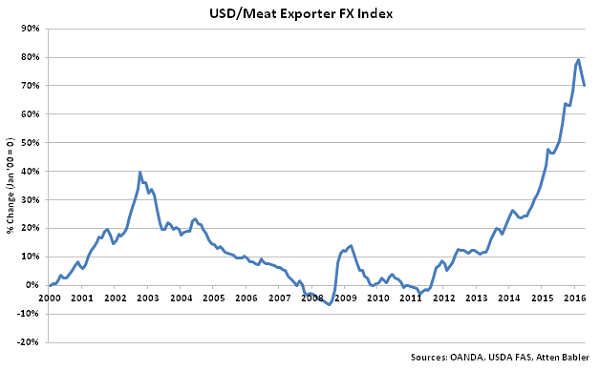 Appreciation against the USD within the USD/Meat Exporter FX Index during Apr ’16 was led by gains by the Brazilian real, followed by gains by the Argentine peso, Belarusian ruble, euro and Canadian dollar.
Appreciation against the USD within the USD/Meat Exporter FX Index during Apr ’16 was led by gains by the Brazilian real, followed by gains by the Argentine peso, Belarusian ruble, euro and Canadian dollar.
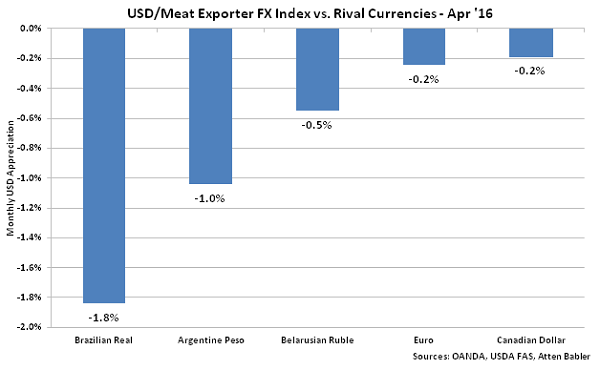 USD/Meat Importer FX Index:
The USD/Meat Importer FX Index increased 16.4 points during Apr ’16 to a new record high value of 257.5. The USD/Meat Importer FX Index has increased 77.8 points since the beginning of 2014 and 32.8 points throughout the past six months. A strong USD/Meat Importer FX Index results in less purchasing power for major meat importing countries (represented in red in the Global Meat Net Trade chart), making U.S. meat more expensive to import. USD appreciation against the Angolan kwanza and the Venezuelan bolivar has accounted for the majority of the gains since the beginning of 2014.
USD/Meat Importer FX Index:
The USD/Meat Importer FX Index increased 16.4 points during Apr ’16 to a new record high value of 257.5. The USD/Meat Importer FX Index has increased 77.8 points since the beginning of 2014 and 32.8 points throughout the past six months. A strong USD/Meat Importer FX Index results in less purchasing power for major meat importing countries (represented in red in the Global Meat Net Trade chart), making U.S. meat more expensive to import. USD appreciation against the Angolan kwanza and the Venezuelan bolivar has accounted for the majority of the gains since the beginning of 2014.
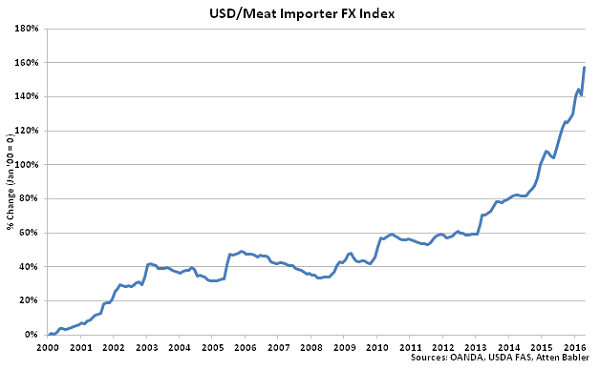 USD appreciation within the USD/Meat Importer FX Index during Apr ’16 was led by gains against the Venezuelan bolivar, followed by gains against the Angolan kwanza. USD declines were exhibited against the South African rand, Japanese yen and Russian ruble.
USD appreciation within the USD/Meat Importer FX Index during Apr ’16 was led by gains against the Venezuelan bolivar, followed by gains against the Angolan kwanza. USD declines were exhibited against the South African rand, Japanese yen and Russian ruble.
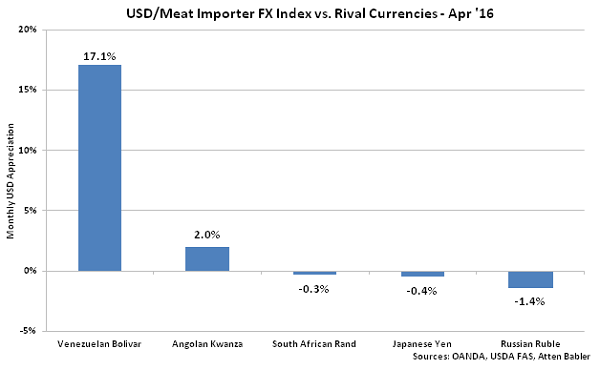 U.S. Meat Export Destinations:
Major destinations for U.S. meat exports are led by Mexico, followed by Japan, China, Canada, and Hong Kong.
U.S. Meat Export Destinations:
Major destinations for U.S. meat exports are led by Mexico, followed by Japan, China, Canada, and Hong Kong.
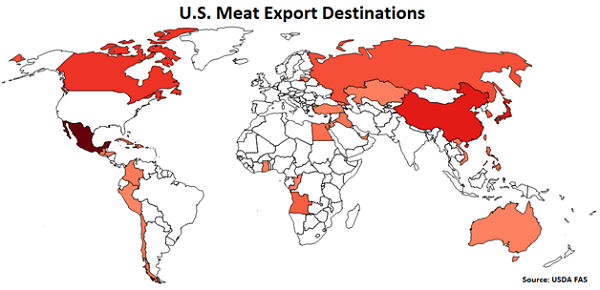 USD/Domestic Meat Importer FX Index:
The USD/Domestic Meat Importer FX Index increased 1.1 points in Apr ’16, finishing at a value of 243.8. The USD/Domestic Meat Importer FX Index finished at the second highest figure on record and has increased 70.3 points since the beginning of 2014 and 20.4 points throughout the past six months. A strong USD/Domestic Meat Importer FX Index results in less purchasing power for the traditional buyers of U.S. meat (represented in red in the U.S. Meat Export Destinations chart), ultimately resulting in less foreign demand, all other factors being equal. USD appreciation against the Angolan kwanza has accounted for the majority of the gains since the beginning of 2014.
USD/Domestic Meat Importer FX Index:
The USD/Domestic Meat Importer FX Index increased 1.1 points in Apr ’16, finishing at a value of 243.8. The USD/Domestic Meat Importer FX Index finished at the second highest figure on record and has increased 70.3 points since the beginning of 2014 and 20.4 points throughout the past six months. A strong USD/Domestic Meat Importer FX Index results in less purchasing power for the traditional buyers of U.S. meat (represented in red in the U.S. Meat Export Destinations chart), ultimately resulting in less foreign demand, all other factors being equal. USD appreciation against the Angolan kwanza has accounted for the majority of the gains since the beginning of 2014.
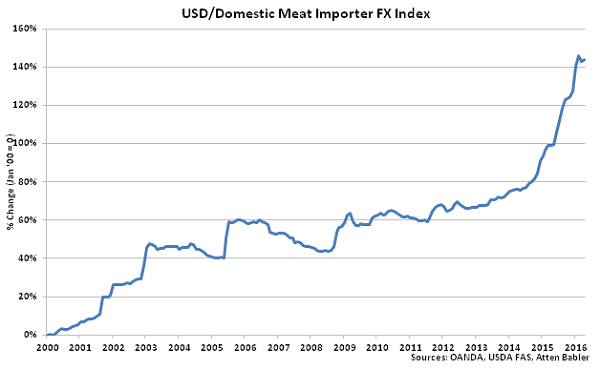 USD appreciation within the USD/Domestic Meat Importer FX Index during Apr ’16 was led by gains against the Angolan kwanza, followed by gains against the Egyptian pound. USD declines were exhibited against the Japanese yen, Mexican peso and Russian ruble.
USD appreciation within the USD/Domestic Meat Importer FX Index during Apr ’16 was led by gains against the Angolan kwanza, followed by gains against the Egyptian pound. USD declines were exhibited against the Japanese yen, Mexican peso and Russian ruble.

 USD/Meat Exporter FX Index:
The USD/Meat Exporter FX Index finished lower for the second consecutive month during Apr ’16, declining 4.3 points to a value of 170.0. The USD/Meat Exporter FX Index remained at the fourth highest figure on record and has increased 48.1 points since the beginning of 2014 and 7.0 points throughout the past six months. A strong USD/Meat Exporter FX Index reduces the competitiveness of U.S. meat relative to other exporting regions (represented in green in the Global Meat Net Trade chart), ultimately resulting in less foreign demand, all other factors being equal. USD appreciation against the Argentine peso and Brazilian real has accounted for the majority of the gains since the beginning of 2014.
USD/Meat Exporter FX Index:
The USD/Meat Exporter FX Index finished lower for the second consecutive month during Apr ’16, declining 4.3 points to a value of 170.0. The USD/Meat Exporter FX Index remained at the fourth highest figure on record and has increased 48.1 points since the beginning of 2014 and 7.0 points throughout the past six months. A strong USD/Meat Exporter FX Index reduces the competitiveness of U.S. meat relative to other exporting regions (represented in green in the Global Meat Net Trade chart), ultimately resulting in less foreign demand, all other factors being equal. USD appreciation against the Argentine peso and Brazilian real has accounted for the majority of the gains since the beginning of 2014.
 Appreciation against the USD within the USD/Meat Exporter FX Index during Apr ’16 was led by gains by the Brazilian real, followed by gains by the Argentine peso, Belarusian ruble, euro and Canadian dollar.
Appreciation against the USD within the USD/Meat Exporter FX Index during Apr ’16 was led by gains by the Brazilian real, followed by gains by the Argentine peso, Belarusian ruble, euro and Canadian dollar.
 USD/Meat Importer FX Index:
The USD/Meat Importer FX Index increased 16.4 points during Apr ’16 to a new record high value of 257.5. The USD/Meat Importer FX Index has increased 77.8 points since the beginning of 2014 and 32.8 points throughout the past six months. A strong USD/Meat Importer FX Index results in less purchasing power for major meat importing countries (represented in red in the Global Meat Net Trade chart), making U.S. meat more expensive to import. USD appreciation against the Angolan kwanza and the Venezuelan bolivar has accounted for the majority of the gains since the beginning of 2014.
USD/Meat Importer FX Index:
The USD/Meat Importer FX Index increased 16.4 points during Apr ’16 to a new record high value of 257.5. The USD/Meat Importer FX Index has increased 77.8 points since the beginning of 2014 and 32.8 points throughout the past six months. A strong USD/Meat Importer FX Index results in less purchasing power for major meat importing countries (represented in red in the Global Meat Net Trade chart), making U.S. meat more expensive to import. USD appreciation against the Angolan kwanza and the Venezuelan bolivar has accounted for the majority of the gains since the beginning of 2014.
 USD appreciation within the USD/Meat Importer FX Index during Apr ’16 was led by gains against the Venezuelan bolivar, followed by gains against the Angolan kwanza. USD declines were exhibited against the South African rand, Japanese yen and Russian ruble.
USD appreciation within the USD/Meat Importer FX Index during Apr ’16 was led by gains against the Venezuelan bolivar, followed by gains against the Angolan kwanza. USD declines were exhibited against the South African rand, Japanese yen and Russian ruble.
 U.S. Meat Export Destinations:
Major destinations for U.S. meat exports are led by Mexico, followed by Japan, China, Canada, and Hong Kong.
U.S. Meat Export Destinations:
Major destinations for U.S. meat exports are led by Mexico, followed by Japan, China, Canada, and Hong Kong.
 USD/Domestic Meat Importer FX Index:
The USD/Domestic Meat Importer FX Index increased 1.1 points in Apr ’16, finishing at a value of 243.8. The USD/Domestic Meat Importer FX Index finished at the second highest figure on record and has increased 70.3 points since the beginning of 2014 and 20.4 points throughout the past six months. A strong USD/Domestic Meat Importer FX Index results in less purchasing power for the traditional buyers of U.S. meat (represented in red in the U.S. Meat Export Destinations chart), ultimately resulting in less foreign demand, all other factors being equal. USD appreciation against the Angolan kwanza has accounted for the majority of the gains since the beginning of 2014.
USD/Domestic Meat Importer FX Index:
The USD/Domestic Meat Importer FX Index increased 1.1 points in Apr ’16, finishing at a value of 243.8. The USD/Domestic Meat Importer FX Index finished at the second highest figure on record and has increased 70.3 points since the beginning of 2014 and 20.4 points throughout the past six months. A strong USD/Domestic Meat Importer FX Index results in less purchasing power for the traditional buyers of U.S. meat (represented in red in the U.S. Meat Export Destinations chart), ultimately resulting in less foreign demand, all other factors being equal. USD appreciation against the Angolan kwanza has accounted for the majority of the gains since the beginning of 2014.
 USD appreciation within the USD/Domestic Meat Importer FX Index during Apr ’16 was led by gains against the Angolan kwanza, followed by gains against the Egyptian pound. USD declines were exhibited against the Japanese yen, Mexican peso and Russian ruble.
USD appreciation within the USD/Domestic Meat Importer FX Index during Apr ’16 was led by gains against the Angolan kwanza, followed by gains against the Egyptian pound. USD declines were exhibited against the Japanese yen, Mexican peso and Russian ruble.
